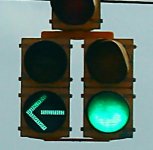Y
Yourjones
Guest
Hi, these are typical traffic lights. Can you help explain in SPOKEN English:
1. when we can only go straight, but can not turn to the left;
2. when we can only turn to the left but can not go straight.
Thank you so much for your patience.
1. when we can only go straight, but can not turn to the left;
2. when we can only turn to the left but can not go straight.
Thank you so much for your patience.
